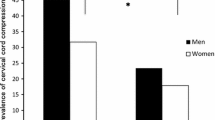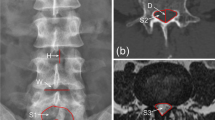Abstract
Purpose
The purpose of this study was to develop a simple and clinically useful morphological classification system for congenital lumbar spinal stenosis using sagittal MRI, allowing clinicians to recognize patterns of lumbar congenital stenosis quickly and be able to screen these patients for tandem cervical stenosis.
Methods
Forty-four subjects with an MRI of both the cervical and lumbar spine were included. On the lumbar spine MRI, the sagittal canal morphology was classified as one of three types: Type I normal, Type II partially narrow, Type III globally narrow. For the cervical spine, the Torg-Pavlov ratio on X-ray and the cervical spinal canal width on MRI were measured. Kruskal–Wallis analysis was done to determine if there was a relationship between the sagittal morphology of the lumbar spinal canal and the presence of cervical spinal stenosis.
Results
Subjects with a type III globally narrow lumbar spinal canal had a significantly lower cervical Torg-Pavlov ratio and smaller cervical spinal canal width than those with a type I normal lumbar spinal canal.
Conclusion
A type III lumbar spinal canal is a globally narrow canal characterized by a lack of spinal fluid around the conus. This was defined as “functional lumbar spinal stenosis” and is associated with an increased incidence of tandem cervical spinal stenosis.


Similar content being viewed by others
References
Dagi TF, Tarkington MA, Leech JJ (1987) Tandem lumbar and cervical spinal stenosis. Natural history, prognostic indices, and results after surgical decompression. J Neurosurg 66(6):842–849. doi:10.3171/jns.1987.66.6.0842
Teng P, Papatheodorou C (1964) Combined cervical and lumbar spondylosis. Arch Neurol 10:298–307
Lee MJ, Garcia R, Cassinelli EH, Furey C, Riew KD (2008) Tandem stenosis: a cadaveric study in osseous morphology. Spine J 8(6):1003–1006. doi:10.1016/j.spinee.2007.12.005
Bajwa NS, Toy JO, Young EY, Ahn NU (2012) Is congenital bony stenosis of the cervical spine associated with lumbar spine stenosis? An anatomical study of 1072 human cadaveric specimens. J Neurosurg Spine 17(1):24–29. doi:10.3171/2012.3.SPINE111080
Singh A, Tetreault L, Fehlings MG, Fischer DJ, Skelly AC (2012) Risk factors for development of cervical spondylotic myelopathy: results of a systematic review. Evid-Based Spine-Care J 3(3):35–42. doi:10.1055/s-0032-1327808
Schizas C, Theumann N, Burn A, Tansey R, Wardlaw D, Smith FW, Kulik G (2010) Qualitative grading of severity of lumbar spinal stenosis based on the morphology of the dural sac on magnetic resonance images. Spine (Phila Pa 1976) 35(21):1919–1924. doi:10.1097/BRS.0b013e3181d359bd
Singh K, Samartzis D, Vaccaro AR, Nassr A, Andersson GB, Yoon ST, Phillips FM, Goldberg EJ, An HS (2005) Congenital lumbar spinal stenosis: a prospective, control-matched, cohort radiographic analysis. Spine J 5(6):615–622. doi:10.1016/j.spinee.2005.05.385
Pavlov H, Torg JS, Robie B, Jahre C (1987) Cervical spinal stenosis: determination with vertebral body ratio method. Radiology 164(3):771–775. doi:10.1148/radiology.164.3.3615879
Bajwa NS, Toy JO, Young EY, Ahn NU (2012) Establishment of parameters for congenital stenosis of the cervical spine: an anatomic descriptive analysis of 1066 cadaveric specimens. Eur Spine J 21(12):2467–2474. doi:10.1007/s00586-012-2437-2
Iizuka H, Takahashi K, Tanaka S, Kawamura K, Okano Y, Oda H (2012) Predictive factors of cervical spondylotic myelopathy in patients with lumbar spinal stenosis. Arch Orthop Trauma Surg 132(5):607–611. doi:10.1007/s00402-012-1465-z
Lee SH, Kim KT, Suk KS, Lee JH, Shin JH, So DH, Kwack YH (2010) Asymptomatic cervical cord compression in lumbar spinal stenosis patients: a whole spine magnetic resonance imaging study. Spine (Phila Pa 1976) 35(23):2057–2063. doi:10.1097/BRS.0b013e3181f4588a
Bajwa NS, Toy JO, Ahn NU (2013) Is congenital bony stenosis of the cervical spine associated with congenital bony stenosis of the thoracic spine? An anatomic study of 1072 human cadaveric specimens. J Spinal Disord Tech 26(1):E1–E5. doi:10.1097/BSD.0b013e3182694320
Bajwa NS, Toy JO, Ahn NU (2012) Is lumbar stenosis associated with thoracic stenosis? A study of 1072 human cadaveric specimens. Spine J 12(12):1142–1146. doi:10.1016/j.spinee.2012.10.029
Bajwa NS, Toy JO, Ahn NU (2013) Application of a correlation between the lumbar Torg ratio and the area of the spinal canal to predict lumbar stenosis: a study of 420 postmortem subjects. J Orthop Traumatol: Off J Italian Soc Orthop Traumatol 14(3):207–212. doi:10.1007/s10195-013-0237-z
Hukuda S, Kojima Y (2002) Sex discrepancy in the canal/body ratio of the cervical spine implicating the prevalence of cervical myelopathy in men. Spine (Phila Pa 1976) 27(3):250–253
Author information
Authors and Affiliations
Corresponding author
Ethics declarations
Conflicts of interest
The authors declare that they have no conflict of interest.
Source of funding
The authors did not receive any outside funding or grants directly related to the research presented in this manuscript. The authors state that this manuscript is an original work only submitted to this journal. The authors hold the rights to all the material presented in this manuscript. All authors contributed to the preparation of this work. This study was approved by our institutional review board (IRB).
Rights and permissions
About this article
Cite this article
van Eck, C.F., Spina III, N.T. & Lee, J.Y. A novel MRI classification system for congenital functional lumbar spinal stenosis predicts the risk for tandem cervical spinal stenosis. Eur Spine J 26, 368–373 (2017). https://doi.org/10.1007/s00586-016-4657-3
Received:
Revised:
Accepted:
Published:
Issue Date:
DOI: https://doi.org/10.1007/s00586-016-4657-3




